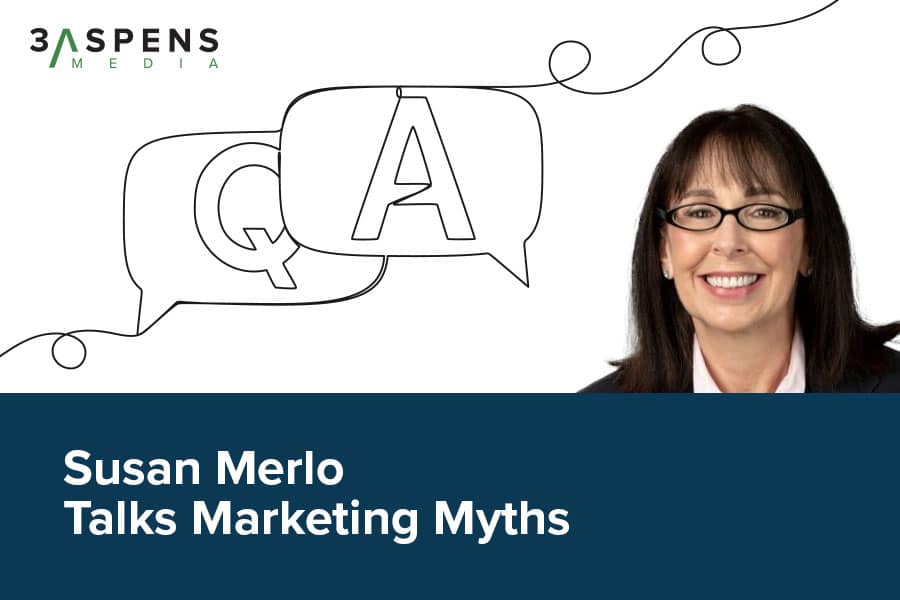Today’s distribution customers spend more time researching their options online than ever before. They also expect more seamless buying experiences that involve more digital channels. The traditional sales approach no longer works, and distributors must change how they reach and interact with customers.
Knowing this, it’s clear that marketing must play a bigger role in distributors’ strategies if they want to succeed. The key is distinguishing between effective marketing for distributors and bad marketing practices built around common misconceptions, or myths. Distributors need to know which marketing tactics work today and which are based on misconceptions before they deploy a strategy.
Lindsay Young, President of 3 Aspens Media, and Susan Merlo, a consultant specializing in digital sales and marketing strategies for the wholesale distribution industry, recently discussed this topic in a live webinar. Susan Merlo is the author of The Digital Distributor: Six Steps to Accelerate Sales and founder of The Digital Distributor™, an organization that helps wholesale distributors leverage digital channels to reach their target audience and close more sales. During the webinar, Young and Merlo covered five common marketing myths that hold distributors back from success. Susan helped dispel those myths and provide clarity.
Myth #1: Distributor marketing needs to be salesy to make a difference.

Lindsay Young: Marketing should not be a list of product features. Although such an approach is appropriate at the right time, to the right person in the right part of the sales funnel, marketing must provide real value. People don’t want to be sold to anymore. What’s your take?
Susan Merlo: You’re right. What customers are looking for in a distributor is a partner to help solve their business problems, whether it’s with a product or service. It’s hard to distinguish one distributor from another because many sell the same products. However, you can demonstrate your value in how you sell products, partner with your customers and provide solutions (that include the products) that matter to your customers.
“You can demonstrate your value in how you sell products, partner with your customers and provide solutions that matter to your customers.”
Susan Merlo
Distributors provide a lot of value but are typically bad at promoting it. Your sales reps and technical specialists have a wealth of expertise that can be leveraged and used across marketing channels to support the customer journey at every stage.
For example, you can offer advice on how to select the right industrial hose for a specific application at the top of the funnel. Adding value at every stage means that you may be giving away free advice, but you’re providing value and you’re reflecting your company’s expertise. The value isn’t salesy. It isn’t focused on what they want to buy, but on how you can you serve them. If it’s a level playing field when it comes to products, who’s going to bring the most value to the customer? That’s what they’re deciding when they’re choosing their distributor.
“If it’s a level playing field when it comes to products, who’s going to bring the most value to the customer? That’s what they’re deciding when they’re choosing their distributor.”
Myth #2: Leads from newsletter signups and form fills are qualified.
Young: Newsletter signups are the equivalent to getting a business card from a prospect in a trade show fishbowl. If you follow up with those people, they’re not necessarily looking to buy from you, but you have made a connection with them. This goes to how leads are qualified and managed today.

Merlo: That’s right. Today, automation can nurture and then qualify leads for you. You don’t have to leave it to the salesperson to keep following up with them. If someone signs up for a newsletter, they just want to be in touch. Distributors need an automated plan for those cold leads, such as sending them introductory information to see if they bite.
“Distributors need an automated plan for those cold leads (from newsletter signups), such as sending them introductory information to see if they bite. If someone fills out an online form for information, that’s a warm lead, and a sales rep should follow up on that right away.”
If someone fills out an online form for information, that’s a warm lead, and a sales rep should follow up on that right away. That doesn’t always happen because all the leads are typically thrown into a spreadsheet for the sales rep to review. It’s not a good use of the sales rep’s time to sort through those, and that’s where automation will help by starting to segment these leads in the sales funnel. Every lead is a good lead and you have to put those leads into the top of your funnel, but not all of them deserve the sales rep’s time at the start. And since automation can touch distributors at every stage of the funnel, planning to have content at every stage of the journey is required.
Myth #3: Personalization is adding someone’s name to an email.
Young: It’s important to send content to every lead, but the content has to be personalized, especially since email is such a good platform for marketing. For example, it’s not personalized content if you’re sending a mining customer information targeted for a food and beverage processor. They are in different worlds, carry different products, have different applications and very different pain points. Obviously, personalization goes way beyond inserting someone’s name in an email. What’s your take on that?
Merlo: Personalization has really come a long way. Years ago, it was a big feat to get your name on your email. Now, you can segment your audience to personalize at a more granular level. However, if you’re sending a mass email to 5,000 people, it’s very hard to get that granular.

By building your digital sales funnel the right way, you can choose segmentation criteria based on different aspects of your audience, depending on your business. You might segment by title or revenue. You can sort by who’s the decision maker and who’s not, who’s the owner of the company and who’s not, or who’s an influencer. Each one of them will get a similar message, but a message that speaks directly to their role so they think you’re talking right to them. You want your lead or customer to say, “Wow, he really gets me,” not “Wow, I should not have wasted time opening that email!”
“You want your lead or customer to say, ‘Wow, he really gets me,’ not ‘Wow, I should not have wasted time opening that email!’”
Another piece of personalization that we should talk about is your website. Once you have your lists segmented, you should personalize their experience on the website. For example, if you sell to small residential contractors and large commercial contractors, you’re selling to two different audiences. They’re providing two different kinds of service, but they’re both buying from you. When small residential contractors come to your website, they want to see images and content that reflect their business. The large commercial contractors want to see office buildings and institutions and business suits. Setting up landing pages that reflect each buyer’s needs and your solutions to their pain points provides a personalized experience.
“Setting up landing pages that reflect each buyer’s needs and your solutions to their pain points provides a personalized experience.”
Myth #4: B2B distributor marketing doesn’t work.
Young: All marketing firms hear this from customers from time to time. That blog didn’t drive any sales, that email didn’t work. Google ads aren’t converting our website. Nobody’s using the shopping cart. The myth is it doesn’t work, but it’s really about the long game. Susan, what’s your take on this?
Merlo: The short answer is: If it’s not working, then you’re not doing it right. The old saying: “50% of my marketing works, but I don’t know which 50%” no longer applies.
There are two points to make here. The first is to track the results of everything you do. You put a coupon in the paper and measure how many people used the code to purchase product. Did we make $1,000 and the ad cost us $800? Well, we made 20% – let’s run it again.
It’s the same thing for every aspect of marketing. If it’s not measurable at that basic or, preferably, sophisticated level, then you need to figure out how to make it measurable.

The second point is that you must personalize your content based on your segmented list. For example, if you send an email out to your entire group of contractors aimed toward small contractors, but they’re only 10% of your mailing list, the campaign won’t have much success. If you send out information aimed toward your audience, it works.
Let me just say this: If distributors knew how well marketing can work for them, and I say this all the time, they’re going to kick themselves when they find out what they could have been doing with those big expensive CRMs all this time.
“[Distributors will] kick themselves when they find out what they could have been doing with those big expensive CRMs all this time.”
You can measure the success of individual promotions. It’s very easy to do, but just because they didn’t work doesn’t mean that they’re not worth doing. It just means you might have to try another way. For example, sending the promotion just to the specific customer segment because it’s the right time of year for them to buy. Having that data and information is going to go a long way. Then you measure the results and improve on it next time. There are individual data points you can measure along the way, website traffic, but ultimately, the goal of marketing is to support the customer journey and keep them in the funnel until they’re ready to buy.
Young: Ideally, marketing is used to support the sales process. It’s a digital collaboration with the sales team to move it forward. You build online resources to nurture a long game. You can’t look at a campaign in a silo; it goes toward a broader strategy to engage customers where they’re at. And consistency is key, which can be hard for many companies to do on their own.
Myth 5: You can do it all.
Young: There are so many different tools, processes and channels that distributors can use to reach their customers. But they don’t have to build from scratch – they can partner with marketing and content providers to build the resources and campaigns they need.
Merlo: I agree, Lindsay. Distributors are one of the last industries that relied on that face-to-face sales relationship. Now there’s more digital available to them, and there’s nothing that they are going to do in their marketing that hasn’t already been done before in another industry. They just need to have a plan and goals and a process. They need to determine what works, look at other industries’ results and talk to marketing experts.

We’ll tell them what works because we know what works. And then we help them develop a plan and find out what their goals are, what they’re trying to achieve. One of the hardest things for distributors to do is to clean their list and get it segmented. That’s the first step. It’s really hard to get that information from your salespeople, but it’s got to be done. And there are services that do it for you.
“One of the hardest things for distributors to do is clean their list and get it segmented – but it’s got to be done.”
And a big point I want to make is that it’s important to figure out what your goals are and what data you want to gather before investing in the technology. Because you don’t need big tools, you just have to know how to use the tools you have. And usually it’s difficult to know how to use them until you know what you want from them.
“Figure out what your goals are and what data you want to gather before investing in the technology.”
If you’re a smaller company with a one- to two-person marketing department, make it their job to obtain and monitor that data and outsource other marketing chores so they can concentrate on segmenting and knowing who their audience is and what their pain points are. There are consultants and marketing companies like ours that know distribution really well that can help them on this journey – they don’t have to do it alone.
This summary only scratches the surface of the invaluable advice Merlo gave in the webinar! Watch the entire discussion below.



